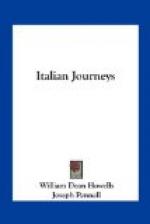The ancestral house of the Ariosti has been within a few years restored out of all memory and semblance of itself; and my wish to see the place in which the poet was born and spent his childhood resulted, after infinite search, in finding a building faced newly with stucco and newly French-windowed.
Our portier said it was the work of the late English Vice-Consul, who had bought the house. When I complained of the sacrilege, he said: “Yes, it is true. But then, you must know, the Ariosti were not one of the noble families of Ferrara.”
VI.
The castle of the Dukes of Ferrara, about which cluster so many sad and splendid memories, stands in the heart of the city. I think that the moonlight which, on the night of our arrival, showed me its massive walls rising from the shadowy moat that surrounds them, and its four great towers, heavily buttressed, and expanding at the top into bulging cornices of cavernous brickwork, could have fallen on nothing else in all Italy so picturesque, and so full of the proper dread charm of feudal times, as this pile of gloomy and majestic strength. The daylight took nothing of this charm from it; for the castle stands isolated in the midst of the city, as its founder meant that it should [The castle of Ferrara was begun in 1385 by Niccolo d’Este to defend himself against the repetition of scenes of tumult, in which his princely rights were invaded. One of his tax-gatherers, Tommaso da Tortona, had, a short time before, made himself so obnoxious to the people by his insolence and severity, that they rose against him and demanded his life. He took refuge in the palace of his master, which was immediately assailed. The prince’s own life was threatened, and he was forced to surrender the fugitive to the people, who tore Tortona limb from limb, and then, after parading the city with the mutilated remains, quietly returned to their allegiance. Niccolo, therefore, caused this castle to be built, which he strengthened with massive walls and towers commanding the whole city, and rendered inaccessible by surrounding it with a deep and wide canal from the river Reno.], and modern civilization has not crossed the castle moat, to undignify its exterior with any visible touch of the present. To be sure, when you enter it, the magnificent life is gone out of the old edifice; it is no stately halberdier who stands on guard at the gate of the drawbridge, but a stumpy Italian soldier in baggy trousers. The castle is full of public offices, and one sees in its courts and on its stairways, not brilliant men-at-arms, nor gay squires and pages, but whistling messengers going from one office to another with docketed papers, and slipshod serving-men carrying the clerks their coffee in very dirty little pots. Dreary-looking suitors, slowly grinding through the mills of law, or passing in the routine of the offices, are the guests encountered in the corridors; and all that bright-colored throng of the old days, ladies and lords, is passed from the scene. The melodrama is over, friends, and now we have a play of real life, founded on fact and inculcating a moral.




